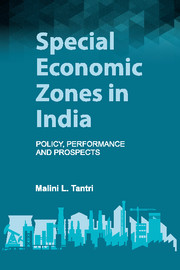Book contents
- Frontmatter
- Contents
- List of Tables, Figures, Charts and Maps
- Preface
- Acknowledgements
- Abbreviations
- 1 Introduction
- 2 Export Processing Zones to Special Economic Zones: Trajectories of Policymaking
- 3 China's Experience with Special Economic Zones under a Liberalized Regime – Highs and Lows
- 4 Performance of Special Economic Zones: Promises, Realizations and Paradoxes
- 5 An Assessment of the Fiscal Viability of Special Economic Zones
- 6 Special Economic Zones and the Question of Efficiency
- 7 Conclusions
- Bibliography
- Index
4 - Performance of Special Economic Zones: Promises, Realizations and Paradoxes
Published online by Cambridge University Press: 13 September 2017
- Frontmatter
- Contents
- List of Tables, Figures, Charts and Maps
- Preface
- Acknowledgements
- Abbreviations
- 1 Introduction
- 2 Export Processing Zones to Special Economic Zones: Trajectories of Policymaking
- 3 China's Experience with Special Economic Zones under a Liberalized Regime – Highs and Lows
- 4 Performance of Special Economic Zones: Promises, Realizations and Paradoxes
- 5 An Assessment of the Fiscal Viability of Special Economic Zones
- 6 Special Economic Zones and the Question of Efficiency
- 7 Conclusions
- Bibliography
- Index
Summary
Background
Special economic zones in the Indian context are improved versions of export processing zones on the lines of China's SEZs. Compared to EPZs, the current SEZ policy is more concrete in terms of objectives as well as institutional arrangements. Thus, such a pragmatic shift in the policy regime towards better institutional arrangements and world class infrastructure has helped increase confidence of investors over time, as can be clearly observed from a steady increase in the number of SEZ projects that have been approved in the country and also in the steep increase in the number of exporting units within such enclaves. In this connection, it would be interesting to explore: (a) how have SEZs, with a more nuanced trade policy regime governing them, fared in comparison with EPZs? That is, whether the policy intervention in 2000 has had any positive impact on the working and performance of SEZs; and (b) what are the corresponding dimensions at the disaggregate level? In this context, earlier studies, while analysing the trade performance of Indian EPZs/SEZs, seem to have failed in analysing rigorously the effectiveness of SEZs over EPZs both at the aggregate and disaggregate levels. Rather what is presented in the literature seems mere description of the data available over the years. Furthermore, there is dearth of studies that look into whether there exist variations in the performance of SEZs across zones from a holistic perspective.
These issues are explored and analysed in this chapter based on the aggregated data collected from the seven conventional SEZs,1 namely Kandla, Santacruz, Noida, Cochin, Chennai, Falta and Vizag. Needless to add here that the inclusion of new SEZs in the study will not help throw much light on the issue of SEZ-effectiveness over EPZs. Meanwhile, the primary findings and insights gained during author's extended first-hand fieldwork in these seven zones2 have been utilized to validate the main findings. The analysis has been carried out for the period 1986−87 to 2007−083 with the time period under consideration being long enough to analyse the effectiveness of the SEZ policy, enacted in 2000−01, as against that of the EPZs. A brief account of each SEZ is provided in Table 4.1.
- Type
- Chapter
- Information
- Special Economic Zones in IndiaPolicy, Performance and Prospects, pp. 85 - 116Publisher: Cambridge University PressPrint publication year: 2016



